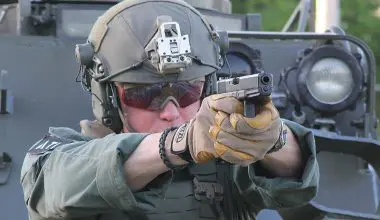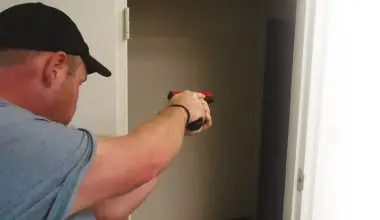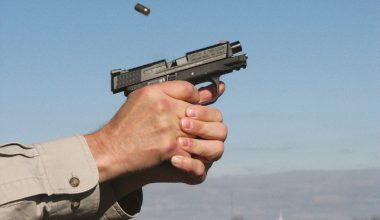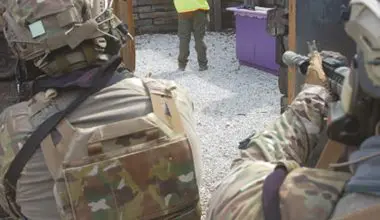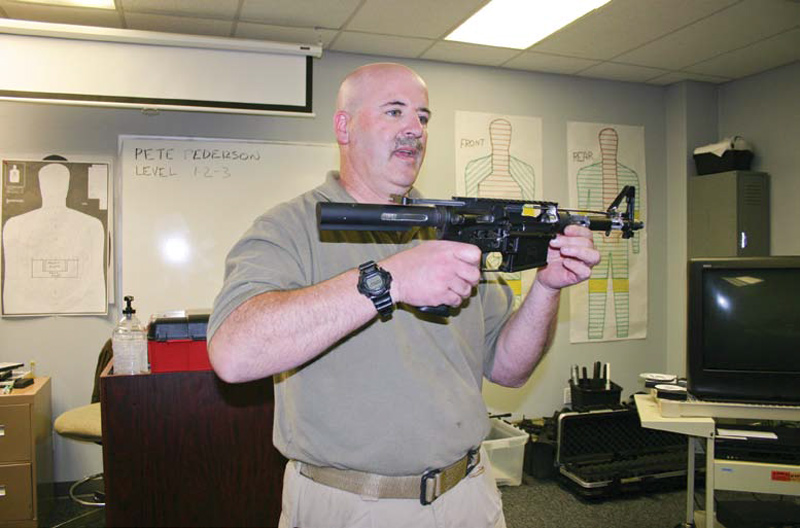
Since that time the AR world has virtually exploded with new makers, parts, accessories, tools, and maintenance products.
The reasons for this are the expiration of the so-called Assault Weapons ban in September 2004; the constant images of ARs and M4s in the media stemming from the current armed conflicts; and people’s ability to conduct online research and join the virtual communities of interest that have sprouted up.
The end result is that more companies now produce ARs in the U.S. than any other model of firearm, and the market for them is equally large. According to BAFTE figures, more than 337,000 AR-15 type rifles were manufactured in the U.S. in 2008, accounting for 22% of all domestically produced rifles that were not exported.
This is a positive thing, not only because ARs are ergonomic, fun to shoot, easy to set up, and accessorize in a variety of configurations—as well as being very effective for defensive use—but also because the more people who own these types of firearms, the greater the constituency to defend the right to own them and other semiautomatic militarystyle firearms.
This expansion of the AR market includes the law enforcement community in a huge way—both as patrol rifles and as long arms to equip special response units. As an extension of this, the demand for armorers, both from departments and among firearms enthusiasts, has also taken off.
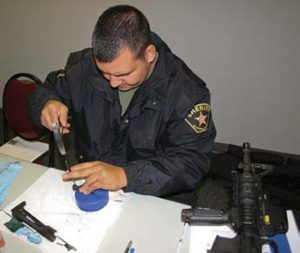
Table of Contents
ARMORER COURSE
This brings us to our course, which was conducted by Gregg “Sully” Sullivan. Sully is a 20+ year law enforcement veteran who runs his own company, Defensive Edge. This company features both a firearm production division and a training unit. It was in the latter capacity that he offered this twoday armorer’s class at the DFW (Dallas- Fort Worth) Gun Range.
Sully has done many things in the law enforcement (LE) field, though most of his current activities involve training for the Minnesota police agency with which he currently serves. He was first introduced to the AR platform in the late 1980s and has had a passion for the system ever since, much of which comes from wanting to see these guns in LE hands.
Given the growth of the AR in LE use, it’s not surprising that three of the ten students in our class were police officers. The remainder of the class included everyone from a gunsmith to someone who had fired his first AR just ten months earlier. This was quite an undertaking for a newcomer, since we would not just be field stripping the firearms, but disassembling the guns to their most basic components.
In light of the greater number of companies producing ARs, Sully makes a special effort to insure that what he teaches applies to all gas impingement system ARs. Throughout the course, he detailed issues that affect specific manufacturers, as well as things to check with guns from those companies. He referred to these as “company signature marks.”
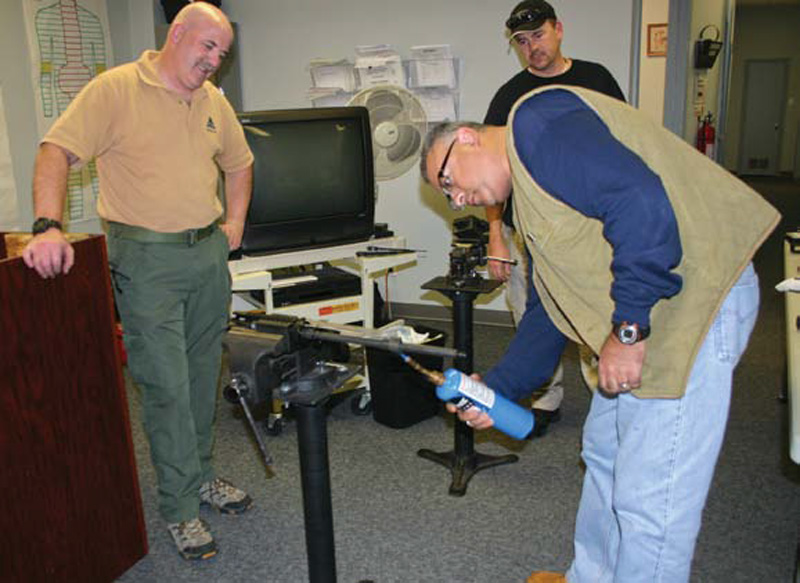
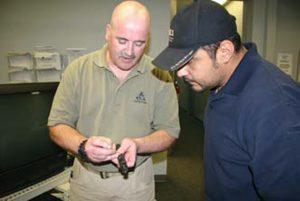
COURSE MATERIALS
We entered the classroom to find several rows of tables already set up with a position for each participant that included a manual, all of the tools needed for the class neatly laid out, and a white towel to use as a disassembly surface and a backdrop to keep from losing small parts.
This represented excellent planning and forethought on Sully’s part, as did bringing a wide variety of spare parts to replace those that were worn in our guns or that we still managed to lose. Given the springs that inevitably got loose and shot around, every student was also provided with a pair of wraparound safety glasses.
Sully even brought several vises to enable us to disassemble and reassemble certain parts. These proved essential on the second day when we removed and reinstalled barrels, and also were indispensable for removing a stuck gas tube.
The manual, developed by Sully, was ours to keep. But Sully needed to hang on to the tools to enable his self-contained traveling armorer’s class to continue on to its next destination. He did provide us with a list of tools and sources for buying them. Everyone brought their own AR, though Sully will provide them for students if notified in advance. However, using our own gun enabled us to inspect the entire firearm as we progressed through the class, and to replace any small parts that needed it.
KROIL TIME
The class began with Sully guiding us through treating various pins, parts, and holes with Kroil oil. For most of us, this was an introduction to Kroil—a penetrating lubricant or “creeping” oil that can seep into tight places to loosen frozen parts and break up corrosion and rust. It also served as an introduction to many of the holes and pins that we “Kroiled,” since most of us had never noticed them before. In bad cases of frozen parts, Sully advises applying this product and letting it stand for up to a day to allow it to seep in.
We Kroiled virtually every part and pin that would be disassembled, in order to give it time to soak in. Sully cautioned against letting this oil get near live ammo, as it would eat through primers. Needless to say, it is also important to thoroughly clean any trace of it off anything that might come in contact with ammo.
LECTURE #1
Once the Kroiling was complete, Sully delivered a lecture on the function of the AR, one of several lectures that he would provide over the course of the two-day class. This included the AR’s history as well as ballistics and ammo selection.
Sully broke the gun’s operation down to cycles of fire, of which the gun has eight: feeding, locking, firing, unlocking, extracting, ejecting, cocking and chambering. These are important in troubleshooting an AR, because when a gun breaks down, it is usually failing to complete a cycle. Thus pinpointing where the problem is helps narrow the search. We examined each cycle and discussed some commonly encountered problems. In explaining this, Sully used cutaway guns, slides, and parts.
Also covered were care and maintenance of the AR. When it came to cleaning the gun, he stressed that the AR does not have to be white-glove clean, but instead reasonably clean. He relayed problems that he has witnessed over the years as an instructor, trainer and AR manufacturer.
Sully is a big believer in SLIP 2000 cleaning and lubrication products. He also pointed out that grease is not a good lubricant for an AR, since it can freeze in extreme cold and will cake up with carbon, as opposed to a purposedesigned gun oil that is formulated to break up the carbon. He also covered specific problems that carbon buildup can cause to different parts of the gun.
Speaking of cleaning, Sully warned against using Simple Green to clean an AR, because it can remove anodizing. He also pointed out that it’s important to use a brass brush and solvent or a suitable tool to break up the carbon buildup on the bolt’s tail. He warned that if carbon were allowed to accumulate in that area, chunks of it could break off and float around in the gas system. This was quite different than what I had been told by some other people.
Sully used a special groove in noted gunsmith Ned Christiansen’s MOACKS II tool to completely remove the carbon from the tail of our bolts. This $175 tool was primarily designed to stake carrier keys, but also contains a hole that allows the bolt tail to be inserted and rotated, which quickly strips away carbon buildup.
The two most common problems that Sully encounters are loose or improperly staked carrier keys and chambers not cut to 5.56mm, which is actually a bit larger than .223. While 5.56mm ammo can be fired through .223 chambers, it can result in malfunctions such as popped primers, especially when the gun gets dirty. SAAMI (Small Arms and Ammunition Manufacturers Institute) considers firing 5.56mm ammo in .223 Rem. chambers to be an unsafe practice.
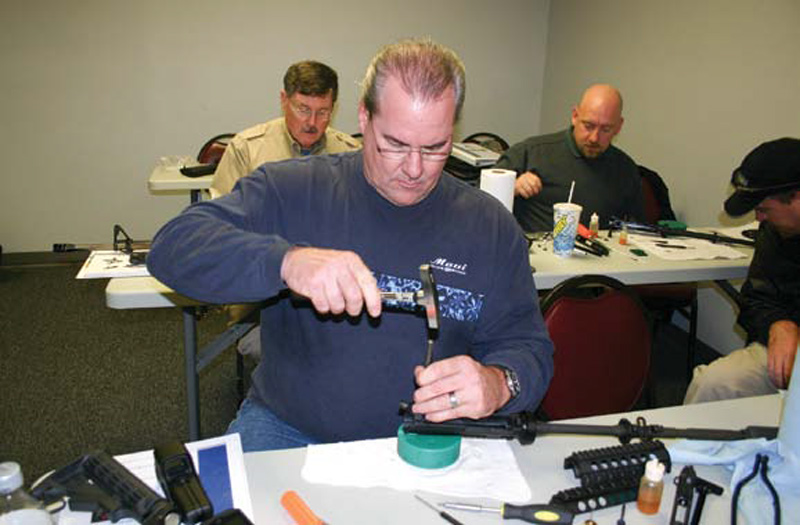
DISASSEMBLY
We checked the class members’ ARs with Sully-supplied go/no-go gauges and found that some needed a slight chamber reaming to be true 5.56mm, even though their barrels were marked as such.
In disassembling and reassembling the ARs, Sully demonstrated many nuances, such as how to position a part or a certain way to apply pressure—things that are not immediately apparent.
After going over basic fieldstripping early the first day, we graduated to detailed disassembly of the lowers and removed every subcomponent until we were left with bare lowers. Reassembly proved tricky, and Sully made sure to walk us through staking the castle nut of the receiver extension, aka buffer tube.
By the time the first day of class was over, we’d disassembled certain parts of the lower several times.
PART BY PART
As we disassembled the guns, Sully delved into the history of each part, its development and applications to new products such as the M4. Whenever students were engaged in any handson activity, Sully constantly circulated among them, offering help and insuring that everyone was following along.
As well as bringing good parts to replace any that had worn on our guns, Sully also included a selection of substandard and broken parts, which he passed around the room to compare to parts that met specifications.
We spent some time exploring the history of the extractor insert. People typically use the black insert for the M4 or 16-inch AR since it is the stiffest. However, Sully pointed out that color alone is not a reliable indicator of hardness and that some blues are as hard as the standard black.
While relatively simple, replacing an extractor spring is not part of field stripping and thus is overlooked by many people. This component should be replaced every 5,000 rounds or so.
Sully also touched on the subject of match parts and match triggers. He acknowledged that they might give someone an edge in competition, but stressed that they could compromise reliability and thus did not belong in any gun that one might stake their life on.
DAY TWO
The second day began with a review of what we had learned with the lower, including some hands-on practice, then we moved on to the upper. When fully disassembling the upper, we discovered how much more complex the A2 rear sight is than the A1, with certain reassembly activities being counterintuitive. It is no surprise that Sully chooses to make the A1 rear sight standard on the guns his company produces.
After the sights were addressed, we moved on to the forward assist. By the time we were done, we had removed every part of the upper, including the barrel. While it is possible to remove the barrel by placing the upper on a chair and sitting on it to provide leverage while using the proper wrench, a vise is much easier. The vise proved necessary to stabilize the gun when removing one student’s stuck gas tube, and was critical for reattaching the barrels.
We also learned what not to do, such as trying to add M4 feed ramps with a Dremel tool on uppers that do not have them. While the M4 feed ramp is good to have on a semi-auto gun, Sully warned against trying to Dremel them in yourself if your gun lacks them.
WHO’S IT FOR?
Over the two-day course, we completely disassembled our guns several times. Disassembly of an AR down to its pins and parts is a skill that is perishable if not practiced on a regular basis or performed enough times that it becomes second nature.
Even if you don’t plan on engaging in any armorer activities, the class will really help you to understand and appreciate the AR platform. It will prove invaluable for anyone considering building their own gun from parts or even needing to replace simple parts that are not accessible through basic fieldstripping.
Whether you are planning to work on ARs, build your own gun, or just want to understand more about how the gun works, Sully’s AR Armorer Course has something for you.

